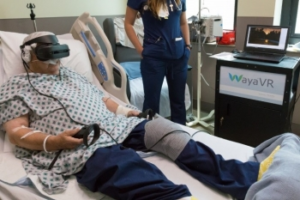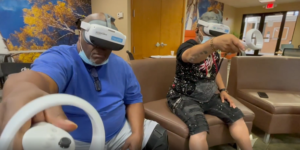<< Back to Media
VHA and Virtual Reality: Innovations in Chronic Pain Management
October 31, 2023
Many U.S. military Veterans can now manage their pain without taking a pill. Veterans Health Administration (VHA) is leading the way in the implementation of immersive technology, such as virtual reality (VR) and augmented reality (AR), in clinical care delivery, offering Veterans an option to help manage chronic pain, anxiety, depression, and PTSD without using medications, such as opioids and benzodiazepines, that carry risks for abuse and addiction.
VHA collaborates with academia and private industry to remain at the forefront of health innovation. As the largest integrated healthcare system in the United States, VHA provides extraordinary healthcare to over nine million Veterans each year. Although Veterans make up a small portion of the U.S. adult population, they are more likely than non-Veterans to have psychological distress, chronic health conditions, and chronic pain that require treatment. Through its Office of Healthcare Innovation and Learning (OHIL), VHA restores hope and builds trust with Veterans by providing immersive technology, like VR, when it’s needed.
Bringing Joy to Hospitals
Extended reality (XR) is an umbrella term for VR and AR and typically includes a head-mounted display with or without integrated headphones, handheld controllers, or other physical items. It may require a laptop, tablet, or other smart device. VR is the most immersive form of XR, allowing the patient to learn, explore, or even interact in an engaging virtual environment.

Caitlin Rawlins, BSN, RN, assists a Veteran with using VR therapy following a total knee arthroplasty. Photo courtesy of the Department of Veterans Affairs.
In a 2021 interview, Caitlin Rawlins, Deputy Director of Clinical Tech Innovation, said immersive technology has helped “decrease pain levels, decrease anxiety and relax patients in pain.” She said,
“…we’re able to bring that kind of relief to [Veterans] in a non-pharmacological, non-invasive way, that actually brings joy to a hospital where most people don’t feel a lot of joy.”
The Opioid Crisis
As a result of widespread opioid abuse and overprescribing, countless Veterans struggle with addiction. An estimated 65.5 percent of U.S. military Veterans reported pain due in part to their military service, with more than 9 percent reporting severe pain.
VHA found that opioid prescriptions increased by 7 percent from 2001 to 2009, increasing the risk of addiction and abuse. Many of these substances worsen the symptoms of anxiety, depression, and PTSD. Without proper clinical treatment and follow-up, there is an even greater risk of Veterans self-medicating with drugs and alcohol, potentially leading to further health complications.
Immersive technologies provide safe, engaging forms of distraction, or behavioral therapy, to treat substance use disorders and addiction. The technologies can also prevent self-medication and provide an alternative to traditional prescriptions.
VHA Innovations
VHA is advancing the implementation of immersive technology through collaboration with private industry, academia, and other government agencies. New studies at prestigious hospitals, such as Cedars Sinai and Harvard Health, are also advancing VR as a non-pharmaceutical treatment. Dr. Brennan Spiegel, MD, MSHS, Director of Cedar-Sinai’s Health Service Research, said in a 2019 Cedars Sinai interview,
“Our results support previous research that VR can meaningfully reduce pain using a nonaddictive, drug-free treat for people [who] experience a range of different pain conditions.”
VHA has a long and remarkable history of innovation with notable advancements such as implantable cardiac pacemakers, nicotine patches, and 3D-printed prototype alternatives for bone or tissue grafts. VHA has also established patient-centered care models in which Veterans have a voice in making decisions about their care, including what kinds of treatment or medications they prefer when alternatives are available.
As part of OHIL, VA Immersive provides immersive technology-related resources for staff and patients across VHA. VA Immersive has identified more than forty unique uses of immersive technology across more than 170 VHA facilities. At the Western North Carolina VA Healthcare Center, VR has been used over 600 times to help address pain, stress, anxiety, and boredom. Feedback from Veterans at this site included feelings of enjoyment, and said,
“It was fun and really did help distract me from my back discomfort. Let’s do that again.”
Reaching Veterans Wherever They Are
Dr. Anne Lord Bailey, Executive Director of OHIL’s Strategic Initiatives Lab and Immersive Technology Lead, said in a VA-produced video that “immersive technology [is] in every state and Puerto Rico [which] enables us to reach Veterans no matter where they are.” The technology is now available in Guam and American Samoa, too.
VA Immersive has reached across the country to help as many Veterans as possible, with numerous multi-site pilot programs already established. Donations of XR equipment are present at more than 35 VA sites and drive the engagement of over 2100 VHA employees and staff within VA Immersive’s collaborative community, the VHA XR Network.

Photo Courtesy of the Department of Veterans Affairs.
As of December 2022, more than 1000 Veterans have engaged with VR as part of their VHA healthcare path, and Veteran Rudy Medinia encouraged even more Veterans to try VR. He said,
“Going through the things we do as Veterans… especially us who have gone through drug abuse, alcohol abuse, and mental health issues – it takes you out of yourself.”
Staff and employees who employ immersive technology in patient care note improvements in Veteran morale, with over 69 percent of Veterans reporting a reduction in acute or chronic pain intensity. Caitlin Rawlins emphasized this on the VA website:
“As soon as you get a patient in a headset, you see first-hand how immersive technology is transforming Veteran lives.”
How WBD is Helping
In October 2021, WBD secured a contract to work with VHA to advance their innovation in emerging technologies through OHIL. “As a service-disabled veteran-owned small business, we’re thrilled to support the entire innovation ecosystem,” said Scott Caldwell, Co-founder and President of WBD.
We work with VHA leaders to overcome barriers and improve care delivery through innovative ideas. Our consultants utilize their program management, data analytics, event management, and health communications strategies to navigate the complex government healthcare system so that our VHA partners can focus on advancing care for its Veterans.
OHIL’s Innovation Ecosystem and VA Immersive are just two of the many national programs where WBD supports VA Innovation. Our firm takes immense pride in collaborating with VHA to advance innovation, provide logistics and contract management, and promote the usage of new technologies and care programs that benefit VHA leaders, caregivers, and Veterans.
Authors: Sharon Driscoll, MBA, BSN, is a Lead Consultant at WBD supporting the Veterans Health Administration (VHA); and Melanie Eckberg, Ph.D., is a Lead Consultant at WBD and a scientific, technical writer supporting the National Institutes of Health (NIH).
